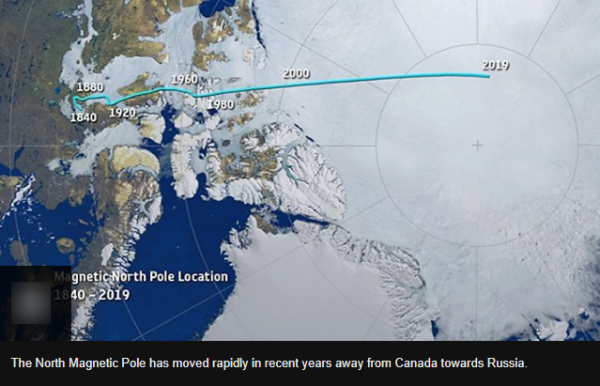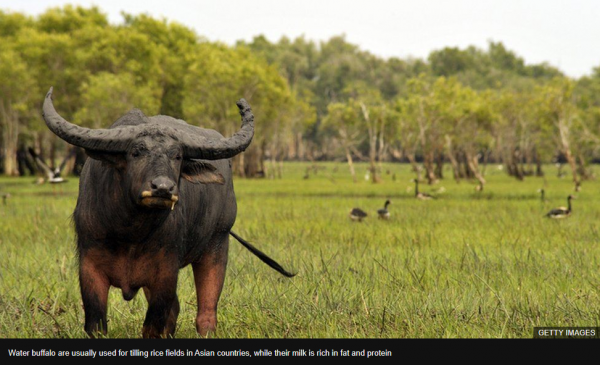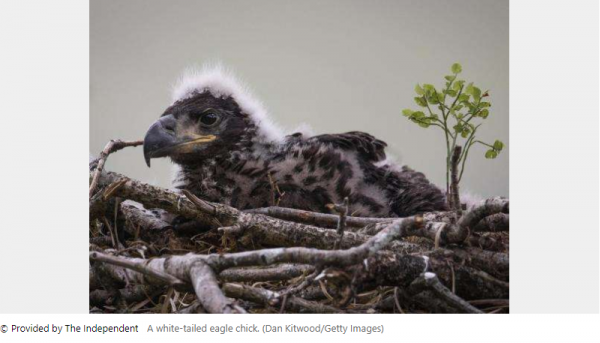-
Posts
20,849 -
Joined
-
Last visited
-
Days Won
49
Everything posted by CaaC (John)
-

Premier League Confirmed Transfers
CaaC (John) replied to CaaC (John)'s topic in Premier League - English Football Forum
Yep Manchester United's New Signing Marc Jurado Holds Record For The Fastest Youth Goal Ever Scored Sports Bible -
Funny you posted that @Stan because at the same time or thereabouts the Red Arrows flew over Edinburgh too and as we only live about a mile away from the capital they passed right over us and scared the shite out of the wife, she said "What the FUCK was that...", I clicked on and said, "more than likely a fly over honey as it's VEDay".
-
Australia's oldest and much-loved hippopotamus Brutus dies at Adelaide Zoo Zookeepers in Adelaide are farewelling one of their biggest and most popular attractions — the much-loved hippopotamus Brutus, who was euthanased this morning at the age of 54. The hippo was one of the largest and longest-standing residents at Adelaide Zoo, which said he was the oldest hippo in Australia before his death. He was euthanased by zoo staff this morning after his health condition deteriorated. Adelaide Zoo said he lived well beyond the average lifespan of a hippo, and nothing more could be done to improve his quality of life. "Brutus was unable to hold off the advance of time and our latest aged-animal assessment revealed that there was nothing else that could have been done to improve the quality of his life," Zoos SA chief executive Elaine Bensted said. "Due to his advanced years, and concerns that age-related conditions were likely to cause him further discomfort over the winter period, veterinary staff and keepers made the extremely difficult but kind decision to euthanase." Adelaide Zoo is currently closed because of coronavirus. "We know people from all over South Australia would ordinarily come into the zoo to pay their respects to Brutus, however in the current climate of social distancing, we've had to think of new ways for the public to farewell and celebrate our animals from afar," Ms Bensted said. "That's why we're asking the public to celebrate Brutus's life at home by enjoying a slice or two of watermelon, one of his favourite foods. "We will all miss him greatly and he will never be forgotten." Brutus's female partner Susie died in 2017 at the age of 49 and, at the time, was the oldest female hippopotamus in captivity. Adelaide Zoo also has a pygmy hippopotamus called Obi. Brutus was born at Sydney's Taronga Zoo in 1965 and moved to Adelaide Zoo in 1975.
-
How did ancient frogs move between America and Australia? Easy: They hopped across Antarctica. It’s no secret that millions of years ago, the world looked wildly different than it does today. Continents now separated by massive oceans were once next-door neighbours, and today’s frozen wilderness was temperate and green. And back in those days, it wasn’t cute emperor penguins hopping around Antarctica—it was ancient horned frogs. Swedish scientists discovered 40 million-year-old fossils of the little amphibians on Seymour Island, the only Antarctic spot where sediments aren’t hidden under masses of ice, and published their findings in Scientific Reports last week. “Frogs, nowadays, are known on all six other continents,” says Thomas Mors, the lead author of the study and senior curator at the Swedish Museum of Natural History. “Now we know they were also present on the seventh.” The little croakers that inhabited the icy wasteland millions of years ago weren’t exactly a one-of-a-kind species. The newly discovered amphibian’s skull and ilia, a part of the pelvis, were a dead ringer for the same body parts in a South American frog genus called Calyptocephalella. Just one species from this genus remains in the modern world—the helmeted water toad, which hops around the Andes in Chile. Up until now, the closest cousins to the Calyptocephalella were found in Australia, which is quite a hike from Chile. This newly discovered frog “ties” the two in a way, Mors adds, which provides support for the existence of Gondwana—an ancient “supercontinent” that formed after the original landmass of Pangea split in two. Millions and millions of years ago, Gondwana included what we now call South America, Africa, Arabia, Madagascar, India, Australia, and Antarctica. By the Jurassic period, about 180 million years ago, this giant continent started splitting up into slightly more recognizable chunks. So while it sounds wild that close froggy cousins might be found all the way from South America to Australia, back when these creatures started evolving, Antarctica was a perfectly accessible midway point between the two locales. This study shows how these frogs got their start on one massive ancient continent, allowing them to branch off around the world, says David Wake, an amphibian expert at the University of California Berkeley who was not involved in the study. “It represents the breakup [of Gondwana].” Because the lost Antarctic critters are close cousins of frogs we’re already familiar with, their remains also provide insight into what the area’s climate was like back before it froze over. Using climatic analysis, the researchers hypothesize that ancient Antarctica was wet and temperate, with annual precipitation of around 900 millimetres per year. For Wake, this kind of study is a perfect example of palaeontology in action. There’s more to the field than just bouncing around the globe, digging up things, and hoping for the best. Without knowledge of Gondwana, it’d be pretty bizarre to posit that a frog ever hopped around Antarctica—let alone a specimen extremely similar to frogs spotted today in Chile. Understanding the geological context allows people studying fossils to actually understand them. One aspect of the discovery that Mors finds particularly intriguing is the fact that this fossil predates the freezing over of Antarctica by six million years. Now, he’s curious about how close to the freezing point these frogs survived, and what other animals might have been cosying up in Antarctica’s ancient freshwater ecosystems alongside them. https://www.msn.com/en-gb/news/offbeat/how-did-ancient-frogs-move-between-america-and-australia-easy-they-hopped-across-antarctica/ar-BB13CTCh?li=AAg17eQ#image=1
-
POPULAR SCIENCE ENVIRONMENT Pangea Broke Apart As Fast As Fingernails Grow That's pretty fast for a 20-mile thick continent Hang on to your landmasses: we now know that the continents split apart in a big hurry. University of Sydney researchers studying seismic data from hundreds of millions of years ago found that tectonic plates experience fast and slow periods of motion. The crust, which is up to 20 miles thick in places, would slowly stretch and then suddenly move at 20 times its previous rate. "It's the equivalent of moving around as a pedestrian to moving around in a very fast BMW," Dietmar Muller, an author of the study, told the New York Times. When the connections between continents became too weak to resist forces tearing them apart, the crust moved at 20 millimetres per year. That's nearly the speed at which fingernails grow. The study resulted in a publicly available computer simulation of Pangea's movements, available here.
-
Science & Environment Iceye's small radar satellites achieve a big capability European "new space" company Iceye has demonstrated a radar technique in its small satellites that have in the past been performed only by the biggest of spacecraft. Called Interferometric Synthetic Aperture Radar (InSar), it involves making repeat images of a location to detect millimetric changes in height. The approach has myriad applications, from tracking subsidence to tracing ground ruptures from Earthquakes. Iceye's satellites weigh under 100kg. The high-fidelity spacecraft that have traditionally done this work have weighed perhaps a couple of tonnes. It's another example of how emerging space companies are wringing capability out of small packages - something they can do as they exploit the very latest commercial, "off-the-shelf" technologies, such as those developed for consumer electronics. Start-up's space radar has super-sharp eyes Space agency teams with Finnish start-up Iceye, based in Helsinki, Finland, currently operates four radar satellites in orbit but has plans for many more. InSar marks an important milestone for the company because it is one of the most difficult techniques to master. It requires very precise control of a spacecraft to ensure that when it comes back over the target scene, its images are coherent. "It's all down to the details," said Rafal Modrzewski, CEO at Iceye. "First you have to inject your satellite into its correct orbit, and then precisely monitor and maintain that orbit. And then your radar instrument needs to be precise enough that it retains coherence between consecutive images. Only then it works. These precision achievements tend to be the domain of high-fidelity, expensive systems. It's taken quite a bit of development on our part to get there," he told BBC News. Iceye has been working very closely with an Austrian firm called Enpulsion, which makes small ion engines for satellites. The European Space Agency (Esa), whose own satellites have very much pioneered InSar, has also been advising on the project. Like radar images in general, InSar data requires some expertise to interpret. Analysts will use interferograms to illustrate changes in the shape of the ground below from one satellite pass to the next. Each map is made up of a series of coloured "fringes". Each fringe will describe the movement either away or towards the spacecraft. The technique is used to monitor the stability of infrastructures, such as buildings and bridges. Scientists employ the approach to watch for sagging on a hill slope which might indicate a landslide is imminent, or to alert them to a bulge in the flank of a volcano that's about to erupt. Leeds University's Prof Tim Wright is director of the Centre for Observation and Modelling of Earthquakes, Volcanoes and Tectonics (Comet). His group regularly exploits InSar data acquired by governmental radar satellites, such as Esa's Sentinel-1 system. He commented. "The possibility of doing InSar with these microsatellites at very high resolution with rapid revisit time is really exciting and could open up many new monitoring applications (largely commercial I think)." But he added that it was now for Iceye to show it could deliver regular, quality interferograms. At the moment, the repeat over the same ground target is 18 days. But with many more satellites in orbit, this will come down. Iceye wants to get under 24 hours. https://www.bbc.co.uk/news/science-environment-52560809
-
Final supermoon of 2020 set to grace skies over the UK SLIDES - 1/3 The final supermoon of the year is set to rise in the sky on Thursday. The full moon in May is also known as the “flower moon”, signifying the flowers that bloom during the month. Other names include the hare moon, the corn planting moon, and the milk moon, according to Royal Observatory Greenwich. The celestial event is expected to be visible early in the morning as well as after sunset as the moon rises in the south-east. Greg Brown, an astronomer at the Royal Observatory, told the PA news agency: “Technically the exact moment of a full moon is 11.45 am, however, the moon will not be visible in the sky in the UK at that time.” But the Earth’s natural satellite will still appear bigger than usual on Thursday morning, when it sets at around 5.42 am in London, as well as on Thursday evening, when it rises at around 8.44 pm. He said: “Times for moonrise and set vary slightly across the UK, but not by more than about 10 minutes or so.” This full moon will also be a supermoon, meaning it will be about 6% larger than a typical full moon and around 14% bigger than a micro moon, which is when the moon is at its furthest point from Earth. Dr Brown told PA: “The moon’s orbit He told PA: “Because of how the dynamics of orbits work, these usually occur in runs of two or three with longer gaps of several months between each set of supermoons.” The next supermoon will be visible in April 2021. https://www.msn.com/en-gb/news/uknews/final-supermoon-of-2020-set-to-grace-skies-over-uk/ar-BB13F9Lj#image=1
- 1,657 replies
-
- space exploration
- astronomy
-
(and 1 more)
Tagged with:
-
Science & Environment Scientists explain the magnetic pole's wanderings European scientists think they can now describe with confidence what's driving the drift of the North Magnetic Pole. It's shifted in recent years away from Canada towards Siberia. And this rapid movement has required more frequent updates to navigation systems, including those that operate the mapping functions in smartphones. A team, led from Leeds University, says the behaviour is explained by the competition of two magnetic "blobs" on the edge of the Earth's outer core. Changes in the flow of molten material in the planet's interior have altered the strength of the above regions of negative magnetic flux. FULL REPORT
-
Bloody hell @Bluebird Hewitt, hope it was not one of them below, if so, who is breeding them in Taffy land. Water buffalo attack leaves one dead and two hurt in Usk A man has died after a water buffalo attacked three people at a commercial property. The 57-year-old man was pronounced dead at the scene, after police officers were called to the address at Gwehelog, near Usk, Monmouthshire. A man, 19, was also critically injured and taken to Cardiff's University Hospital of Wales by air ambulance. A woman, 22, suffered a serious leg injury and is being treated at Newport's Royal Gwent Hospital. Gwent Police said they were called to the property at about 14:50 BST on Tuesday and received support from the National Police Air Service. The water buffalo has been destroyed. https://www.bbc.co.uk/news/uk-wales-52552766
-
The Mysterious Desert Towers of Uzbekistan's Lost Civilization SLIDES - 1/5 We drove out of Khiva on a bright and blistering summer morning. The shared taxi passed over the Amu Darya River, pulsing with Himalayan snowmelt, and drove on past rich, irrigated fields and away from the massive domed mosques and medieval tile work of Uzbekistan’s Silk Road cities. We were headed into the former-Soviet Central Asian country’s arid northwestern frontier. Read more at The Daily Beast. https://www.msn.com/en-gb/news/offbeat/the-mysterious-desert-towers-of-uzbekistans-lost-civilization/ar-BB13zH4E#image=1
-
I know buddy that's why I put the 4th May below the title, sometimes some people lose track of the situation and might want to read again, I never saw that yesterday.
-
Coronavirus UK map: How many confirmed cases are there in your area? 4 May 2020 There are now more than 190,000 confirmed coronavirus cases in the UK and 28,734 people with the virus have died. The actual number of cases is estimated to be higher. Until recently it was mostly those in hospital and some NHS and care staff who were being tested - but the testing programme has now been extended. The following charts and graphics will help you understand the situation in the UK and how the authorities are responding. FULL REPORT
-
UK’s largest bird of prey returns to England for the first time in 240 years Britain’s largest bird of prey has returned to the English skies for the first time in 240 years. White-tailed eagles, which have a wingspan up to 2.5 metres, were once a common sight across southern England until the 18th century when they were wiped out by illegal killing. They were last recorded in England in 1780 at Culver Cliff on the Isle of Wight, before becoming extinct in the whole of the UK in 1918 when the final bird was shot on the Scottish Shetland Islands. European populations of the sea eagle also suffered from heavy persecution, which led to significant declines and extinction in several countries, according to the Royal Society for the Protection of Birds (RSPB). But thanks to Forestry England and the Roy Dennis Wildlife Foundation this lost species is making a comeback. Last summer, six young white-tailed eagles were released on the Isle of Wight as part of a five-year project to restore the species to southern England. The birds were collected from the wild in Scotland, where the species was reintroduced in the 1970s under a similar scheme before they were brought to the island. They have been fitted with GPS trackers and the team behind the programme have been tracking four of the young birds as they make their first trips. The satellite data has given the team fascinating insights into the behaviour of the birds, who were largely sedentary over winter but have begun to explore further afield, including Norfolk, Kent and Somerset, now spring has arrived. Two of the eagles, G393, a male, and G318, a female, flew as far the North York Moors. The pair stayed in the national park for days, but also took a trip out to the coast where they spent four hours exploring a 12-mile stretch between Whitby and Saltburn-by-Sea. Another male bird, G274, completed a 325-mile tour of southeast England for three days and appears to have bonded with G324, a female, on the Isle of Wight over the winter months. SLIDES - 1/20 G324 has generally been the most sedentary of the four birds since release but was spotted soaring with paragliders over the west Wight along with G274. White-tailed eagles do not breed until they are about four or five years old, however, it is hoped G274 and G324 might form a breeding pair if they survive until then. Satellite data has given the team fascinating insights into the birds’ behaviour, showing they choose days with the best conditions to make their big moves, preferring a tailwind and clear skies. The birds are known as “sit-and-wait" foragers, who prefer to wait and watch their prey rather than fly great distances for food, which saves valuable energy. Roy Dennis, founder of The Roy Dennis Wildlife Foundation said: “I have spent much of my life working on the reintroduction of these amazing birds and so watching them take to the skies of the Isle of Wight has been a truly special moment. “Establishing a population of white-tailed eagles in the south of England will link and support emerging populations of these birds in the Netherlands, France and Ireland, with the aim of restoring the species to the southern half of Europe.” Bruce Rothnie, from Forestry England, added: “We are immensely proud that the woodlands we manage on the Isle of Wight and surrounding South Coast are now home to these incredibly rare birds as they return to England’s coastline.” Anyone who thinks they have spotted one of the birds can report it online at http://www.roydennis.org/report-white-tailed-eagle-sighting/ https://www.msn.com/en-gb/news/environment/uks-largest-bird-of-prey-returns-to-england-for-first-time-in-240-years/ar-BB13ziXk?li=AAnZ9Ug
-
Coronavirus: 'Missing link' species may never be found An "intermediate host" animal passed the coronavirus from wild bats to humans, evidence suggests. But while the World Health Organization says that the research points to the virus's "natural origin", some scientists say it might never be known how the first person was infected. It remains unclear whether this host animal was sold in the now infamous Wuhan wildlife market in China. But the wildlife trade is seen as a potential source of this "spillover". FULL REPORT
-
The wife on her laptop has just said to me "Oh...the actor Bob Hoskins has died!!", me" You on your Facebook?..." "Yer", me "Well he must have risen from the grave and died again, he died in 2014..." wife gave me a funny look and said nothing else.
-
‘Murder hornets’ found in the U.S. for the first time ever © Provided by New York Daily News Asian giant hornets, known by some researchers as “murder hornets,” have been spotted in the US for the first time ever, the New York Times reported. And just when things were going so well. Asian giant hornets, known by some researchers as “murder hornets,” have been spotted in the US for the first time ever, the New York Times reported. The murder hornets, which can grow up to two inches long, didn’t get their name from murdering people, but instead from their brutal decapitations of honeybees. Scientists in Washington first spotted the hornets back in December, according to the Washington State Department of Agriculture. The murderous insects were also seen north of the border in Br© Provided by New York Daily News While the hornets usually stick to murdering bees, they can kill up to 50 people a year in Japan, according to the Times. Their stingers are longer than a run-of-the-mill honeybee’s. “A few hornets can destroy a hive in a matter of hours, according to the WSDA. “The hornets enter a ‘slaughter phase’ where they kill bees by decapitating them. They then defend the hive as their own, taking the brood to feed their own young.” Multiple beehives in Washington were wiped out by the murder hornets, the Times reported. With bees already dying at an alarming rate, the Asian giant hornets could put an even deeper sting in the American honey industry. A similar hornet invasion in Europe dropped honey production by more than 60%, Time reported. And just when things were going so well. Asian giant hornets, known by some researchers as “murder hornets,” have been spotted in the US for the first time ever, the New York Times reported. The murder hornets, which can grow up to two inches long, didn’t get their name from murdering people, but instead from their brutal decapitations of honeybees. Scientists in Washington first spotted the hornets back in December, according to the Washington State Department of Agriculture. The murderous insects were also seen north of the border in British Columbia. While the hornets usually stick to murdering bees, they can kill up to 50 people a year in Japan, according to the Times. Their stingers are longer than a run-of-the-mill honeybee’s. “A few hornets can destroy a hive in a matter of hours, according to the WSDA. “The hornets enter a ‘slaughter phase’ where they kill bees by decapitating them. They then defend the hive as their own, taking the brood to feed their own young.” Multiple beehives in Washington were wiped out by the murder hornets, the Times reported. With bees already dying at an alarming rate, the Asian giant hornets could put an even deeper sting in the American honey industry. A similar hornet invasion in Europe dropped honey production by more than 60%, Time reported. https://www.msn.com/en-gb/news/offbeat/murder-hornets-found-in-us-for-first-time-ever/ar-BB13w2M2
-
I remember him, 6 months since he last posted.
-
Yes https://www.itv.com/news/channel/2020-03-12/live-updates-number-of-coronavirus-cases-in-the-channel-islands/
-
Scientists Discover a New Compound in Medieval Ink That Was Once Lost to Time Across the Mediterranean region, in fields and on roadsides, thrives a small plant with silvery leaves. It doesn't look like much, and in many cases, it's an annoying weed. But in the Middle Ages, Chrozophora tinctoria was highly prized. There's a clue in the name - tinctoria means to dye, and common names of the plant include dyer's croton and dyer's litmus plant. Medieval artists used its tiny, three-lobed fruit to produce a delicate blue tint called folium or turnsole, for colouring their famous illuminated manuscripts. These dyes fell out of favour by the 17th century for more vivid mineral-based hues, and the secrets for how to extract the pigment from the fruit were lost. But Portuguese scientists studying ancient texts didn't just rediscover and recreate the recipe for folium - they've uncovered the chemical structure of the pigment. And this structure is unlike any other naturally occurring blue pigment; the newly discovered chemical compound has been named chrozophoridin. The key to the discovery is a medieval Portuguese treatise called The book on how to make all the colour paints for illuminating books. It dates back to the 15th century CE, and describes, in detail, the materials and steps for creating paints - basically a medieval paint recipe book. The language used in Portuguese, written phonetically using the Hebrew alphabet, and it was used to create Hebrew sacred texts. A few years ago, the research team started using this book to try and recreate the dyes described therein. It wasn't a purely academic exercise. The illuminated manuscripts that have survived over the centuries are only going to grow more fragile over time. But if we understand the chemistry of the dyes, we can figure out better ways of preserving the colours for future generations. And in 2018, the team did it. Using the specific instructions laid out in The book on how to make all the colour paints for illuminating books, the researchers successfully recreated folium. "It describes when to collect the fruits - in July," chemist Paula Nabais of NOVA University Lisbon told Chemical and Engineering News. "You need to squeeze the fruits, being careful not to break the seeds, and then to put them on linen." The next step - the focus of the team's new paper - was to try to probe the chemical structure of the compound. The colour is extracted from the shell of the fruit; breaking the seed pollutes the pigment, producing a poor quality ink. And it's laborious work: the team soaked the fruit in a methanol-water solution, stirring carefully for two hours. Then the methanol was evaporated under a vacuum, leaving behind a crude blue extract that the team further purified, and concentrated the blue pigment. It was this purified, concentrated pigment that the team analysed using a suite of high-tech techniques, including several types of mass spectrometry and magnetic resonance. The molecular structure the team found was dissimilar from other blue pigments extracted from plants, such as indigo and anthocyanins, the blue pigment found in berries. But it did have a structure in common with a blue chromophore found in another plant - the medicinal herb Mercurialis perennis, or dog's mercury. With a key difference: the chromophore in C. tinctoria has a stable glycosylated structure, which means it is water-soluble - and can, therefore, be transformed into a dye. This discovery means that not only can conservators and scientists recreate the dye to probe its properties, such as its structure and how it reacts to environmental stresses over time, but they can better identify it in medieval manuscripts. "Chrozophoridin was used in ancient times to make a beautiful blue dye for painting, and it is neither an anthocyanin - found in many blue flowers and fruits - nor indigo, the most stable natural blue dye. It turns out to be in a class of its own," the researchers wrote in their paper. "Thus, we believe that this will be not our final word on this amazing plant and its story and that further discoveries will follow soon." The research has been published in Science Advances. https://www.msn.com/en-gb/news/offbeat/scientists-discover-a-new-compound-in-medieval-ink-that-was-once-lost-to-time/ar-BB132WqU#image=1
-
Nasa names companies to develop Moon landers for human missions Nasa has chosen the companies that will develop landers to send astronauts to the Moon's surface in the 2020s. The White House wants to send the next man and the first woman to the Moon in 2024, to be followed by other missions. Jeff Bezos' Blue Origin, Elon Musk's SpaceX and Alabama-based Dynetics were selected to work on landers under the space agency's Artemis programme. The 2024 mission will see astronauts walk on the Moon's surface for the first time since 1972. Combined, the contracts are worth $967m (£763m; €877m) and will run for a "base period" of 10 months. "With these contract awards, America is moving forward with the final step needed to land astronauts on the Moon by 2024, including the incredible moment when we will see the first woman set foot on the lunar surface," said Nasa's administrator Jim Bridenstine. "This is the first time since the Apollo era that Nasa has direct funding for a human landing system, and now we have companies on contract to do the work for the Artemis programme." FULL REPORT
- 1,657 replies
-
- space exploration
- astronomy
-
(and 1 more)
Tagged with:

























